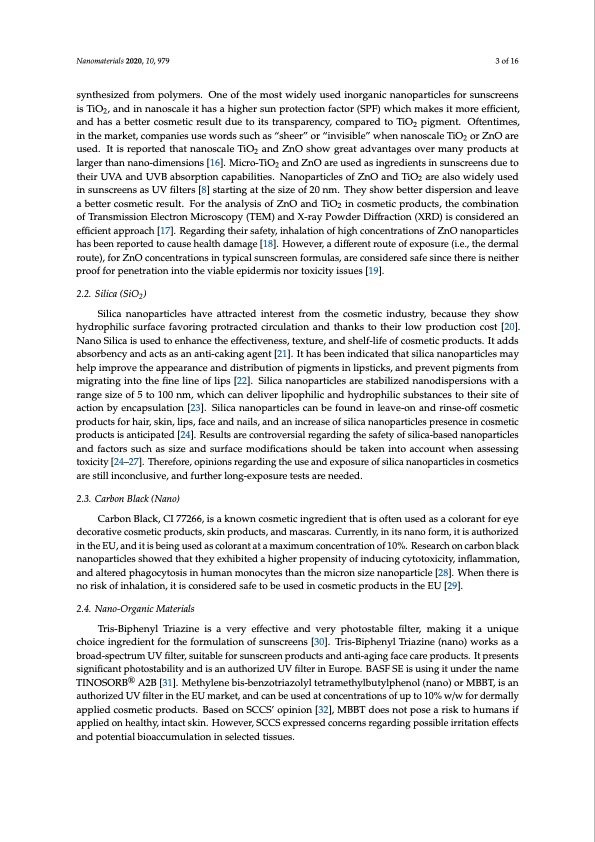
PDF Publication Title:
Text from PDF Page: 003
Nanomaterials 2020, 10, 979 3 of 16 synthesized from polymers. One of the most widely used inorganic nanoparticles for sunscreens is TiO2, and in nanoscale it has a higher sun protection factor (SPF) which makes it more efficient, and has a better cosmetic result due to its transparency, compared to TiO2 pigment. Oftentimes, in the market, companies use words such as “sheer” or “invisible” when nanoscale TiO2 or ZnO are used. It is reported that nanoscale TiO2 and ZnO show great advantages over many products at larger than nano-dimensions [16]. Micro-TiO2 and ZnO are used as ingredients in sunscreens due to their UVA and UVB absorption capabilities. Nanoparticles of ZnO and TiO2 are also widely used in sunscreens as UV filters [8] starting at the size of 20 nm. They show better dispersion and leave a better cosmetic result. For the analysis of ZnO and TiO2 in cosmetic products, the combination of Transmission Electron Microscopy (TEM) and X-ray Powder Diffraction (XRD) is considered an efficient approach [17]. Regarding their safety, inhalation of high concentrations of ZnO nanoparticles has been reported to cause health damage [18]. However, a different route of exposure (i.e., the dermal route), for ZnO concentrations in typical sunscreen formulas, are considered safe since there is neither proof for penetration into the viable epidermis nor toxicity issues [19]. 2.2. Silica (SiO2) Silica nanoparticles have attracted interest from the cosmetic industry, because they show hydrophilic surface favoring protracted circulation and thanks to their low production cost [20]. Nano Silica is used to enhance the effectiveness, texture, and shelf-life of cosmetic products. It adds absorbency and acts as an anti-caking agent [21]. It has been indicated that silica nanoparticles may help improve the appearance and distribution of pigments in lipsticks, and prevent pigments from migrating into the fine line of lips [22]. Silica nanoparticles are stabilized nanodispersions with a range size of 5 to 100 nm, which can deliver lipophilic and hydrophilic substances to their site of action by encapsulation [23]. Silica nanoparticles can be found in leave-on and rinse-off cosmetic products for hair, skin, lips, face and nails, and an increase of silica nanoparticles presence in cosmetic products is anticipated [24]. Results are controversial regarding the safety of silica-based nanoparticles and factors such as size and surface modifications should be taken into account when assessing toxicity [24–27]. Therefore, opinions regarding the use and exposure of silica nanoparticles in cosmetics are still inconclusive, and further long-exposure tests are needed. 2.3. Carbon Black (Nano) Carbon Black, CI 77266, is a known cosmetic ingredient that is often used as a colorant for eye decorative cosmetic products, skin products, and mascaras. Currently, in its nano form, it is authorized in the EU, and it is being used as colorant at a maximum concentration of 10%. Research on carbon black nanoparticles showed that they exhibited a higher propensity of inducing cytotoxicity, inflammation, and altered phagocytosis in human monocytes than the micron size nanoparticle [28]. When there is no risk of inhalation, it is considered safe to be used in cosmetic products in the EU [29]. 2.4. Nano-Organic Materials Tris-Biphenyl Triazine is a very effective and very photostable filter, making it a unique choice ingredient for the formulation of sunscreens [30]. Tris-Biphenyl Triazine (nano) works as a broad-spectrum UV filter, suitable for sunscreen products and anti-aging face care products. It presents significant photostability and is an authorized UV filter in Europe. BASF SE is using it under the name TINOSORB® A2B [31]. Methylene bis-benzotriazolyl tetramethylbutylphenol (nano) or MBBT, is an authorized UV filter in the EU market, and can be used at concentrations of up to 10% w/w for dermally applied cosmetic products. Based on SCCS’ opinion [32], MBBT does not pose a risk to humans if applied on healthy, intact skin. However, SCCS expressed concerns regarding possible irritation effects and potential bioaccumulation in selected tissues.PDF Image | Nanomaterials in Cosmetics: Recent Updates

PDF Search Title:
Nanomaterials in Cosmetics: Recent UpdatesOriginal File Name Searched:
nanomaterials-10-00979-v2.pdfDIY PDF Search: Google It | Yahoo | Bing
Turbine and System Plans CAD CAM: Special for this month, any plans are $10,000 for complete Cad/Cam blueprints. License is for one build. Try before you buy a production license. More Info
Waste Heat Power Technology: Organic Rankine Cycle uses waste heat to make electricity, shaft horsepower and cooling. More Info
All Turbine and System Products: Infinity Turbine ORD systems, turbine generator sets, build plans and more to use your waste heat from 30C to 100C. More Info
CO2 Phase Change Demonstrator: CO2 goes supercritical at 30 C. This is a experimental platform which you can use to demonstrate phase change with low heat. Includes integration area for small CO2 turbine, static generator, and more. This can also be used for a GTL Gas to Liquids experimental platform. More Info
Introducing the Infinity Turbine Products Infinity Turbine develops and builds systems for making power from waste heat. It also is working on innovative strategies for storing, making, and deploying energy. More Info
Need Strategy? Use our Consulting and analyst services Infinity Turbine LLC is pleased to announce its consulting and analyst services. We have worked in the renewable energy industry as a researcher, developing sales and markets, along with may inventions and innovations. More Info
Made in USA with Global Energy Millennial Web Engine These pages were made with the Global Energy Web PDF Engine using Filemaker (Claris) software.
Infinity Turbine Developing Spinning Disc Reactor SDR or Spinning Disc Reactors reduce processing time for liquid production of Silver Nanoparticles.
| CONTACT TEL: 608-238-6001 Email: greg@infinityturbine.com | RSS | AMP |